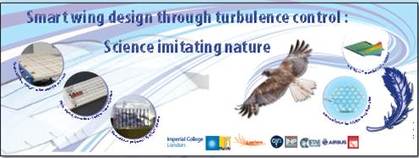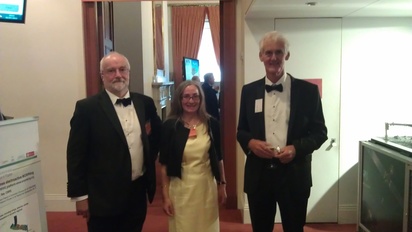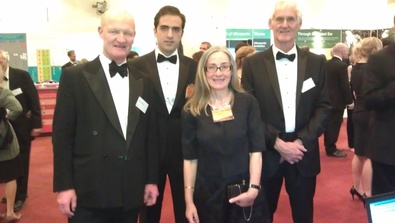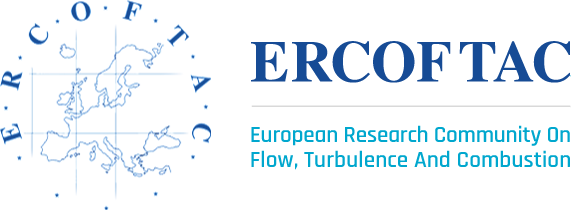Royal Society Summer Exhibition, 2014
Smart Wing Design Through Turbulence Control

Imperial College , London, UK, IMFT, Toulouse, France &
LAPLACE, Toulouse, France
Summer Science Exhibition, Royal Society, London, UK, 2014
Progress in turbulence, mechanics of materials and control is enabling scientists to improve aerodynamic performance by imitating nature in reducing aircraft noise and air resistance
to flight itself. "Smart", bio-inspired technologies together with new dynamically controlled aerodynamic shapes are making flight more environmentally friendly, economically attractive and even safer.
Nature shows us a way into a complex scientific problem – the interaction between a fluid and a structure such as a wing. A combination of new insights into turbulence with new
deformable materials is leading to new ways of adapting and controlling wings to respond to complex flows. For example, Kagome lattices, which can generate waves that pass through a wing with a flexible surface, can be used to reduce aircraft drag. New generation of smart materials actuated by electricity lead to an new axis of aircraft design by MORPHING, allowing for smooth modification of ailerons shape and by means of suitable vibrations, aerodynamic noise reduction. New aircraft designs inspired from big bird wings and feathers
achieve control of the turbulence generated past the edge of the wings:
Increase of lift and decrease of resistance (drag) and simultaneously reduce the aerodynamic noise. A highly novel aspect is the achievement of these improvements altogether, whereas it is well known that current devices devoted to decrease the drag, usually increase the noise. By means of electrical activation of these new materials
(thanks to the Joule and piezoelectric effects, as well as to vibration of electroactive 'feathers' realized by means of new electroactive polymers), the vortex structure past a wing is modified, achieving therefore the so-called Morphing and specific interfaces between turbulent and 'quiet' flow layers become thinner. Surprisingly, these trailing-edge distortions
stimulate small eddies near the surface which reduce the undulating interface between the turbulence and the smooth outer flow. In this way, by turbulence control, we imitate Nature and we achieve the flight improvements in real time. A highly novel aspect is the achievement of these improvements altogether, whereas it is well known that current devices devoted to decrease the drag, usually increase the noise. These facts represent a considerable advance on current ways of using wings to control aircraft with rigid elements, such as
ailerons, tabs, and vortex generators. These new technologies are being studied in experimental demonstrators with novel techniques for simultaneous measurement of the airflow and deforming wing surfaces, as well as by modeling through super-computer simulations of unsteady airflows. Simple and comprehensive experiments are at the visitors
disposal, where the public can 'see' the devices and the aerodynamic flows by means of different demonstrators in the Royal Society stand.
PDF-
Web links:
http://sse.royalsociety.org/2014/
http://www3.imperial.ac.uk/
https://www.imft.fr/
http://www.laplace.univ-tlse.fr/
http://www.smartwing.org
Royal Society Summer Exhibition Soirée, 2 July 2014

L-R:
Prof. Jonathan Morrison (Imperial College), Dr Marianna Braza (IMFT) & Prof. Julian Hunt (UCL)

L-R:
The Rt. Hon. David Willets MP, UK Minister for Universities and Science, joined by :
Dr. Kevin Gouder (ICL), Dr. Marianna Braza (IMFT) and Prof. Julian Hunt (UCL)
